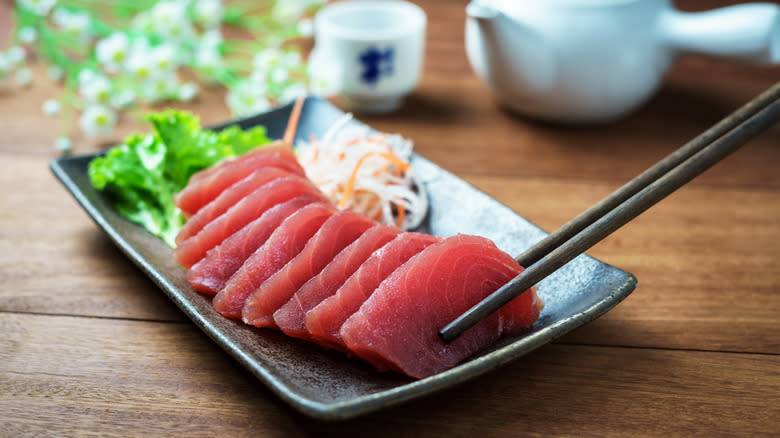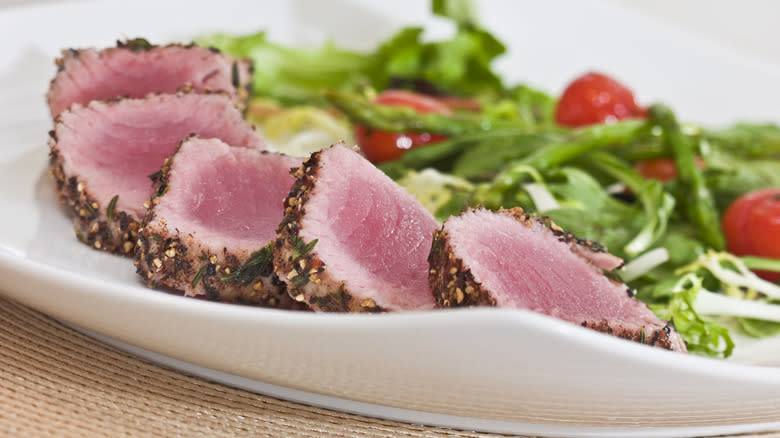How Does Bigeye Tuna Compare To Bluefin?

We may receive a commission on purchases made from links.
Though there are five main varieties of tuna used in cooking, two of the most sought-after are bigeye and bluefin. Of the world's tuna catch, bigeye makes up 18%, and bluefin constitutes 7%. (Skipjack, yellowfin, and albacore make up the rest.) Both bigeye and bluefin tuna are popular choices for sushi, so what's the difference?
Bluefin tuna, as the most coveted, can sell for between $400 and $4,900 per pound. With the largest recorded catch tipping the scales at nearly 1,500 pounds for a single fish in 1979, at the higher price point, that amounts to a lucrative catch. In fact, one bluefin tuna was sold in Japan for $1.76 million in 2013 but was beaten in 2019 by a sale of $3 million at auction, as reported by NBC News. So why is it so valuable? In short, it is regarded as the king of tuna. Because the fish has high-fat marbling in the meat from its cold-water environment, it is known to be highly delicious. Bluefin is particularly tender and delicate and the darkest, fattiest tuna option.
Bigeye tuna is also prized as a sushi or sashimi fish and is known for its thin white fat stripes contrasting against its red flesh. Coming from a warmer environment, it doesn't have as much fat marbling as bluefin and sells for $40 to $200 per pound. Bigeye tuna can grow up to 460 pounds, making them smaller than bluefin but still large at up to 7 feet, 6 inches long.
Read more: 12 Underrated Types Of Fish You Should Try At Least Once
Eating And Cooking With Bigeye And Bluefin Tuna

Both bigeye and bluefin tuna are frequently enjoyed raw in sushi, sashimi, and poke because of their firm but melt-in-your-mouth texture. That said, both varieties of tuna are also excellent as seared steaks, where the edges are crisp, and the inside is still rare.
They're meaty and flavorful on the broader spectrum of all fish, but there are differences in taste when compared to each other. As it's largely considered the milder of the two, bigeye tuna is best for folks who don't like a strong fishy flavor. For real tuna lovers, though, bluefin is the prize with its almost buttery richness.
Both bigeye and bluefin tuna are high in lean protein, niacin, selenium, and vitamin B6 and also low in saturated fat. Although both are a great source of omega-3 fatty acids, bluefin is much higher than bigeye tuna. One of the biggest health concerns with bluefin tuna, however, is that it is higher in mercury than bigeye tuna. Healthline recommends that all species of tuna should be eaten in moderation and avoided entirely by infants, children, and those who are pregnant. It says that mercury builds up over time, and therefore those fish with higher levels of mercury, such as bluefin, should only be consumed as an occasional luxury.
Environmental Concerns For Bluefin And Bigeye Tuna

Because of their popularity, bluefin and bigeye tuna are subject to overfishing concerns. Not only is fishing to extinction a real possibility but removing tuna from the natural food chain is a major worry as well. Tuna are among the top predator species in the ocean, keeping the balance of other populations in check. Without them, the ecosystem in their habitats is thrown out of whack.
Bluefin tuna has been declared endangered by the World Wildlife Foundation. Even with increasingly tight regulations on bluefin tuna fishing, the species is highly impacted by unmonitored tuna fishing. According to the WWF, the bluefin population has declined due to demand in the high-end sushi market, which threatens the species' future.
The World Wildlife Foundation has listed bigeye tuna as a vulnerable species -- not endangered, but still concerning. As bluefin populations become more strained and regulations are enforced on bluefin fishing, bigeye tuna is increasingly overfished to meet market demand. Bigeye tuna schools with skipjack tuna as adolescents, making them vulnerable to accidental catches in skipjack hauls. This poses a particular risk to bigeye as skipjack is the most commonly fished tuna with the least concern surrounding its future.
Read the original article on Daily Meal.

